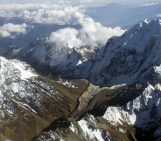
To understand Earth’s changing climate, scientists often examine how the climate has varied in the past, by studying geological records. These records allow us to reconstruct past climates and help us predict planet’s responses to different climate forcings. In this context, it has long been thought that past ice ages on Earth were relatively dry, whereas the warm periods between ice ages were believed to be comparatively wet. For many years, this paradigm has shaped the interpretation of habitat availability and migration patterns of plants, animals, and even humans. Our new research published in Nature (1) reveals that in the Southern Hemisphere ‘subtropics’ (20 to 40° South, Fig. 1), past ice ages were actually much wetter than previously thought, challenging many of these assumptions.

Figure 1. Map of the moisture balance across the Southern Hemisphere subtropics from 20 to 40 degrees South during the summer season (December, January, February). The Naracoorte and Leeuwin-Naturaliste are shown together with the location of six other high-quality records of moisture from southern Africa and South America (red circles). Adapted from Weij et al. (2024).
In the field of palaeoclimatology (the study of past climates), ice ages are known as ‘glacial’ periods, and the intervening warm periods are called ‘interglacial’ periods. Currently, we are living through an interglacial period, the Holocene epoch, which began about 11,700 years ago, following the last glacial period which had persisted since the end of the previous interglacial, about 120,000 years ago. Over the past million years or so, Earth’s climate has oscillated between cold glacial and warm interglacial conditions. Temperatures and atmospheric CO2 concentrations were lower during glacial periods, with expanded ice sheets. During interglacial periods, temperatures and CO2 were much higher and large ice sheets remained only in Greenland and Antarctica.
The notion that the climate of glacial periods was extremely different from today, and profoundly inhospitable for many life forms, especially humans, originally developed in the Northern Hemisphere. There, evidence showed that during glacial periods huge ice sheets spread across boreal regions, and large areas of Europe, northern Asia, and North America south of the ice hosted tundra landscapes. Although large parts of Earth’s surface were remote from these ice- and tundra-dominated landscapes, an idea developed that the climates of glacial periods were harsh and inhospitable pretty much everywhere because evidence from fossil pollen showed that forests were rare or absent from most regions on Earth, in contrast to the widespread importance of forest vegetation during the Holocene. It was also observed that, across the globe, glacial environments were much dustier than today. Because desert regions today often lack trees and produce the most dust, it was reasoned that the dusty treelessness of glacial periods must have also been caused by extremely dry climates.
However, this popular interpretation overlooks the influence of atmospheric CO2 on plant growth. All plants use photosynthesis to grow by converting CO2 into sugars, but methods of photosynthesis vary between different plant types. During glacial conditions when atmospheric CO2 concentrations were low, the photosynthetic efficiency of woody plants (such as trees) was much reduced, so that they could not easily compete with non-woody plants such as grasses. This means that it is more difficult to be a tree in a low CO2 world and that the dustiness of glacial periods may partly reflect less vegetation rather than a drier climate. Our new research reveals that, contrary to this long-held cold-wet/warm-dry view, parts of glacial periods were in fact wetter than today across much of the Southern Hemisphere.

Figure 2. A chamber in one of the Naracoorte caves beautifully decorated with speleothem formations. Source: Rieneke Weij.
What we did
Understanding of past changes in climate and the environment of the Southern Hemisphere has been limited by a lack of well-dated and long-term (more than 100,000 years) records, particularly those from which we can estimate past precipitation levels. We sought to address this problem by studying two cave regions in southern Australia, the Naracoorte caves in the southeast (Fig. 2) and the Leeuwin-Naturaliste caves in the southwest, and used speleothems (cave carbonates such as stalagmites and stalactites) to produce a well-dated climate record spanning the last 350,000 years.
Speleothems form within caves from rainwater infiltrating the overlying soil and limestone rock. We can use the extent of speleothem growth over time to understand changes in water availability: periods with many speleothems growing at the same time broadly reflect wetter conditions, whereas times of low speleothem growth suggest a drier environment. To produce the palaeo-precipitation record, we dated more than 300 individual fragments of speleothem calcite using a radiometric dating technique based upon the decay of natural Uranium in the samples which provides very accurate and precise age determinations.

Figure 3. New records of moisture availability from southern Australia compared to global atmospheric CO2 (Bereiter et al., 2014) and Southern Hemisphere temperature (Parrenin et al., 2013). Note that the previous warm periods (interglacials) are consistently drier than present in both southeastern and southwestern Australia, whereas times of highest moisture availability occur during glacial periods. Adapted from Weij et al. (2024).
Our study revealed surprising yet extremely consistent trends: over the last 350,000 years, wetter times corresponded to the cooler, glacial periods, whereas interglacials were consistently dry (Fig. 3). We also studied fossil pollen trapped within the same speleothems (Fig. 4) and found that moisture-loving plants thrived during the same glacial periods but were suppressed during interglacials, confirming the dating evidence.
These new records from southern Australia were then used as benchmarks for the Southern Hemisphere subtropics. By comparing these with other published records from southern Africa and South America, we found that wet glacials and dry interglacials were not confined to southern Australia, but in fact, formed a hemisphere-wide pattern. Climate model simulations also showed a similar pattern over the last glacial cycle.

Figure 4. Selection of fossil pollen grains extracted from the Naracoorte speleothems. Top from left to right: Pteris, Nertera and Amperea. Bottom from left to right: Monotoca (2x), Banksia marginata and Restionaceae. Source: Kale Sniderman.
Why it matters
For many years a paradigm of hydroclimate variability during glacial–interglacial cycles developed in the Northern Hemisphere has been inappropriately applied to the Southern Hemisphere when interpreting the movement and expansion of plants, animals, and even humans. It was assumed that, during glacial periods, reduced rainfall forced many moisture-demanding plants and animals into small ecological ‘refugia’. Our research suggests that – at least in the subtropical Southern Hemisphere – glacial periods were often times of relatively stable environments with abundant water resources, even if low atmospheric CO2 meant that plants were slow-growing and relatively unproductive. Thus, our research calls for a big paradigm shift in how we view past ice-age environments across the Earth.
References 1) Weij, R., Sniderman, J. K., Woodhead, J. D., Hellstrom, J. C., Brown, J. R., Drysdale, R. N., Reed, E., Bourne, S. & Gordon, J. (2024). Elevated Southern Hemisphere moisture availability during glacial periods. Nature, 626(7998), 319-326.
This blog was edited by the CL editorial board.




